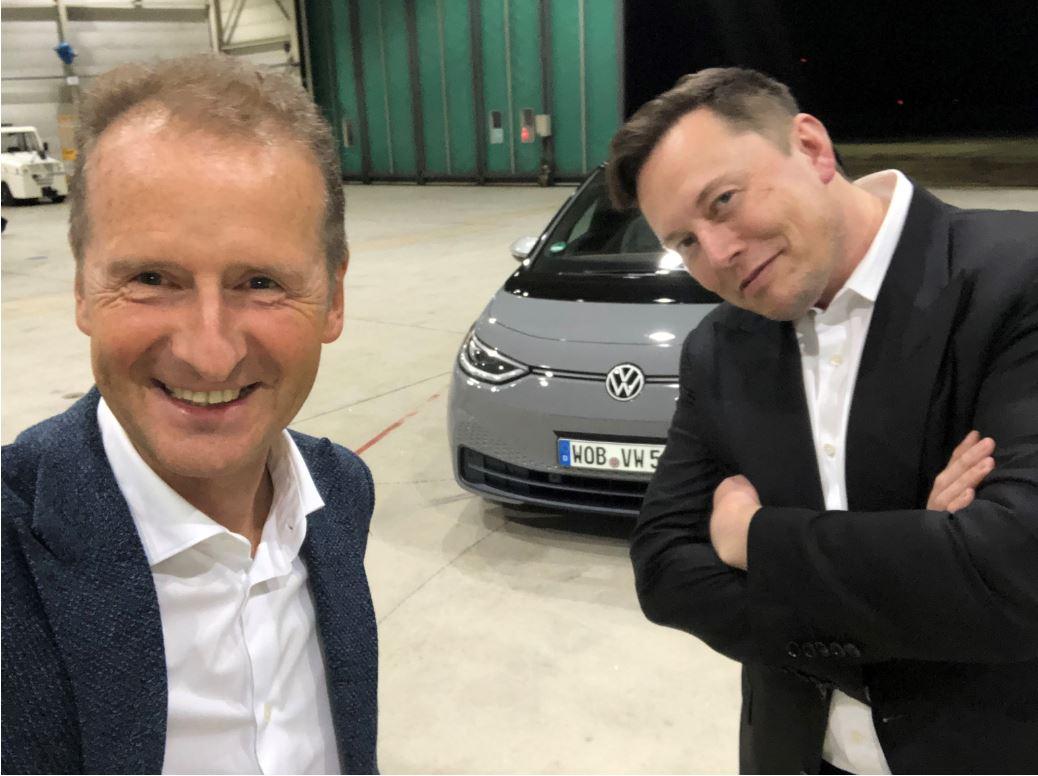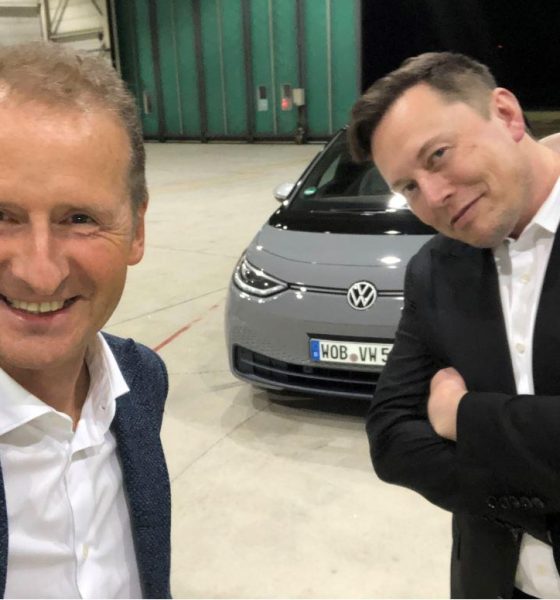

News
Tesla, VW lead the charge for EV dominance as EU sets plan to end combustion engines in 2025
Europe’s current emissions standards have already proven difficult for legacy automakers as evidenced by Honda joining Tesla and Fiat Chrysler’s pool deal recently. But if the EU Commission does decide to push through with its hyper-strict recommended Euro 7 standards, traditional automakers may find it even more difficult to stay competitive in the face of EV manufacturers like Tesla or legacy OEMs who have a leg-up in electric car production and development, like Volkswagen.
All of Tesla’s vehicles are tailor-fit for the strict Euro 7 standards, thanks to its S3XY line, all of which are battery-electric. Tesla recently started exporting Giga Shanghai’s Model 3 vehicle to Europe, thereby increasing its delivery capacity. Gigafactory Berlin seems to be on schedule to start Model Y production in 2021 as well.
On the other side of the aisle, Volkswagen’s ID.3 seems to be selling well in Europe and the ID.4, a crossover, is poised for a release soon. Volkswagen is also working on the other entries of its ID line, such as the ID.5 sedan and estate, the ID.6 SUV, and the ID.7 van. Other all-electric cars from Volkswagen AG, such as the Porsche Taycan and the Audi e-tron, are also being received quite well in their respective segments.
Other traditional OEMs have announced electric vehicles for the future. For instance, Daimler’s Mercedes-Benz brand has announced the EQV, EQS, EQE, and EQA, expanding its existing EV range. Things will likely not be easy for legacy automakers that are only getting their feet wet with EVs, however, as it isn’t just emissions standards that they have to contend with when it comes to releasing new energy vehicles. With each passing year, competitors like Tesla continue to improve the technologies in its vehicles, which also raises the EV standards for traditional OEMs.
The recommendations from the panel of experts in the EU Commissions’ recent study suggests that new car sales in the region will likely be geared towards electric vehicles in the near future. Even if the recommendations end up getting watered down as they are implemented, the shift to electric cars will definitely be palpable within the coming years. And amidst these changes, companies that have already laid the groundwork for their respective electric car programs will likely come out with an advantage.
Tesla would be wise to take advantage of Europe’s apparent war against the combustion engine. With Gigafactory Berlin poised to come online next year, Tesla would have the opportunity to saturate the market with the Model Y, its highest-volume car vehicle to date. The release of the company’s yet-to-be-announced $25,000 EV would also go a long way towards accelerating the mass adoption of all-electric cars. Tesla has not hinted at a concrete release date for its $25,000 car, but with the EU Commission’s stance, it may be a good idea for the electric car maker to accelerate the upcoming vehicle’s release.
Companies like Volkswagen, for their part, would best be advised to ensure that the rollout of its all-electric cars are done with no more delays. The ID.3 experienced severe problems with its software, resulting in the all-electric car’s rollout being pushed back. Amidst Europe’s push to end the internal combustion engine, Volkswagen must ensure that the succeeding vehicles in the ID family are rolled out in a much smoother manner.

Elon Musk
Starlink passes 9 million active customers just weeks after hitting 8 million
The milestone highlights the accelerating growth of Starlink, which has now been adding over 20,000 new users per day.

SpaceX’s Starlink satellite internet service has continued its rapid global expansion, surpassing 9 million active customers just weeks after crossing the 8 million mark.
The milestone highlights the accelerating growth of Starlink, which has now been adding over 20,000 new users per day.
9 million customers
In a post on X, SpaceX stated that Starlink now serves over 9 million active users across 155 countries, territories, and markets. The company reached 8 million customers in early November, meaning it added roughly 1 million subscribers in under seven weeks, or about 21,275 new users on average per day.
“Starlink is connecting more than 9M active customers with high-speed internet across 155 countries, territories, and many other markets,” Starlink wrote in a post on its official X account. SpaceX President Gwynne Shotwell also celebrated the milestone on X. “A huge thank you to all of our customers and congrats to the Starlink team for such an incredible product,” she wrote.
That growth rate reflects both rising demand for broadband in underserved regions and Starlink’s expanding satellite constellation, which now includes more than 9,000 low-Earth-orbit satellites designed to deliver high-speed, low-latency internet worldwide.
Starlink’s momentum
Starlink’s momentum has been building up. SpaceX reported 4.6 million Starlink customers in December 2024, followed by 7 million by August 2025, and 8 million customers in November. Independent data also suggests Starlink usage is rising sharply, with Cloudflare reporting that global web traffic from Starlink users more than doubled in 2025, as noted in an Insider report.
Starlink’s momentum is increasingly tied to SpaceX’s broader financial outlook. Elon Musk has said the satellite network is “by far” the company’s largest revenue driver, and reports suggest SpaceX may be positioning itself for an initial public offering as soon as next year, with valuations estimated as high as $1.5 trillion. Musk has also suggested in the past that Starlink could have its own IPO in the future.
News
NVIDIA Director of Robotics: Tesla FSD v14 is the first AI to pass the “Physical Turing Test”
After testing FSD v14, Fan stated that his experience with FSD felt magical at first, but it soon started to feel like a routine.

NVIDIA Director of Robotics Jim Fan has praised Tesla’s Full Self-Driving (Supervised) v14 as the first AI to pass what he described as a “Physical Turing Test.”
After testing FSD v14, Fan stated that his experience with FSD felt magical at first, but it soon started to feel like a routine. And just like smartphones today, removing it now would “actively hurt.”
Jim Fan’s hands-on FSD v14 impressions
Fan, a leading researcher in embodied AI who is currently solving Physical AI at NVIDIA and spearheading the company’s Project GR00T initiative, noted that he actually was late to the Tesla game. He was, however, one of the first to try out FSD v14.
“I was very late to own a Tesla but among the earliest to try out FSD v14. It’s perhaps the first time I experience an AI that passes the Physical Turing Test: after a long day at work, you press a button, lay back, and couldn’t tell if a neural net or a human drove you home,” Fan wrote in a post on X.
Fan added: “Despite knowing exactly how robot learning works, I still find it magical watching the steering wheel turn by itself. First it feels surreal, next it becomes routine. Then, like the smartphone, taking it away actively hurts. This is how humanity gets rewired and glued to god-like technologies.”
The Physical Turing Test
The original Turing Test was conceived by Alan Turing in 1950, and it was aimed at determining if a machine could exhibit behavior that is equivalent to or indistinguishable from a human. By focusing on text-based conversations, the original Turing Test set a high bar for natural language processing and machine learning.
This test has been passed by today’s large language models. However, the capability to converse in a humanlike manner is a completely different challenge from performing real-world problem-solving or physical interactions. Thus, Fan introduced the Physical Turing Test, which challenges AI systems to demonstrate intelligence through physical actions.
Based on Fan’s comments, Tesla has demonstrated these intelligent physical actions with FSD v14. Elon Musk agreed with the NVIDIA executive, stating in a post on X that with FSD v14, “you can sense the sentience maturing.” Musk also praised Tesla AI, calling it the best “real-world AI” today.
News
Tesla AI team burns the Christmas midnight oil by releasing FSD v14.2.2.1
The update was released just a day after FSD v14.2.2 started rolling out to customers.

Tesla is burning the midnight oil this Christmas, with the Tesla AI team quietly rolling out Full Self-Driving (Supervised) v14.2.2.1 just a day after FSD v14.2.2 started rolling out to customers.
Tesla owner shares insights on FSD v14.2.2.1
Longtime Tesla owner and FSD tester @BLKMDL3 shared some insights following several drives with FSD v14.2.2.1 in rainy Los Angeles conditions with standing water and faded lane lines. He reported zero steering hesitation or stutter, confident lane changes, and maneuvers executed with precision that evoked the performance of Tesla’s driverless Robotaxis in Austin.
Parking performance impressed, with most spots nailed perfectly, including tight, sharp turns, in single attempts without shaky steering. One minor offset happened only due to another vehicle that was parked over the line, which FSD accommodated by a few extra inches. In rain that typically erases road markings, FSD visualized lanes and turn lines better than humans, positioning itself flawlessly when entering new streets as well.
“Took it up a dark, wet, and twisty canyon road up and down the hill tonight and it went very well as to be expected. Stayed centered in the lane, kept speed well and gives a confidence inspiring steering feel where it handles these curvy roads better than the majority of human drivers,” the Tesla owner wrote in a post on X.
Tesla’s FSD v14.2.2 update
Just a day before FSD v14.2.2.1’s release, Tesla rolled out FSD v14.2.2, which was focused on smoother real-world performance, better obstacle awareness, and precise end-of-trip routing. According to the update’s release notes, FSD v14.2.2 upgrades the vision encoder neural network with higher resolution features, enhancing detection of emergency vehicles, road obstacles, and human gestures.
New Arrival Options also allowed users to select preferred drop-off styles, such as Parking Lot, Street, Driveway, Parking Garage, or Curbside, with the navigation pin automatically adjusting to the ideal spot. Other refinements include pulling over for emergency vehicles, real-time vision-based detours for blocked roads, improved gate and debris handling, and Speed Profiles for customized driving styles.








